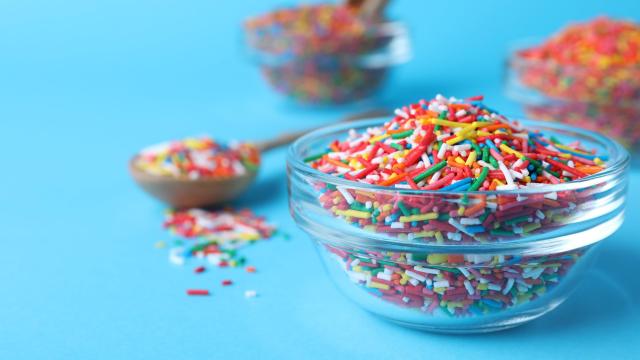I cleaned out my pantry over the weekend and it led to a lot of existential questions, mostly about sprinkles. In addition to my normal stash, which I’ve had for numerous holiday cookie decorating seasons, my sister gifted me an assortment of pastel eggs, lime green sugar, and other bonbons de décoration that she longer needed, in varying stages of use. At the time, I replied with an enthusiastic, “Thank you!” But now I realise I would’ve done better to pose a sceptical, “How old are these?”
When I saw one batch of “holiday stars” sported a 2012 date (thanks, sis), I wondered: Do sprinkles and their holiday baking cohorts expire — and if so, when? Where pantry staples are concerned, I tend to regard expiration dates as suggestions — they’re called non-perishables for a reason. The FDA itself admits, “most date labels are not based on exact science” and they’re commonly provided by manufacturers “to inform consumers and retailers of the date up to which they can expect the food to retain its desired quality and flavour.”
So maybe it won’t taste as good, but that’s a far cry from actually making you sick. Many dates say “Best by” not “Eat by this date or you will surely die.” Also, it’s mostly sugar, so how much can it really spoil? Let’s find out.
Do sprinkles expire?
The simple answer is: Sort of — and when they do, they expire very slowly. They do contain colorants and other additives, and in some cases, even oil. According to Eat By Date, when handled and stored properly, “Sprinkles last for 3-5 years beyond the best by date.” As long as you don’t contaminate them with food-borne pathogens and store them in airtight containers, you can keep using them with no issues several years beyond expiration.
How to know if they’ve expired
Simply looking at your sprinkles can tell you a lot. Visually inspect them for faded colour, spots, mould, and clumping (a sign of moisture). If you don’t see any of those indicators, but you’re still not sure, do a smell test. Any sour or rancid smell earns them an instant toss in the garbage. If you’re still in doubt, there’s no substitute for tasting them. If they’re still sweet, they pass.
What about food colouring?
Most food colouring is comprised of water, glycerine (a sugar alcohol), dye, citric acid, and sodium benzoate (a preservative). (Gel food colouring will also include corn syrup and modified cornstarch.) As many of these ingredients never expire, food colouring has a long shelf life, and can be used several years beyond expiration when tightly sealed and stored at room temperature in a cool, dry place away from sunlight.
If not stored properly, liquid and gel food colouring may harden or dry out over time. When it does — and you can’t make it to the store — add a few drops of hot water and massage the tube to see if it loosens. If it’s hardened beyond repair or shows any signs of mould growth, toss immediately. (Side note: Powdered food colouring, containing zero liquid content, will last longest of all.)
Is it any different with cookie icing?
Cookie icing is a bit murkier. Eat By Date lists a pressure tube of icing’s shelf life as “indefinite — the icing will harden and not work.” Icing manufacturer Wilton, along with Betty Crocker, often use cryptic codes on their packaging such as “H014A” where the letter refers to the month it was produced (H=August), the first number is the last number of the year it was made (0=2020), the next two numbers indicate the day of the month (the 14th), and the last letter refers to the plant where it was produced.
If you don’t feel like translating hieroglyphics when decorating cookies, consider that you can use it until it changes colour, thickens, or smells bad, which will likely be within 18-24 months.
What about other baking staples?
We’ve written before on how to tell whether your baking soda and baking powder will still adequately perform their leavening duties, and how long to keep your flour. In terms of food safety, imitation vanilla extract has an indefinite shelf life, but can lose its flavour and aroma after four years. And, according to Lifehacker’s senior food editor Claire Lower, as long as it’s stored in a cool, dry, ant-less space, “your sugar can hang out forever.”

Leave a Reply
You must be logged in to post a comment.